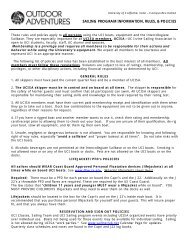J22 Manual - UCI Campus Recreation
J22 Manual - UCI Campus Recreation
J22 Manual - UCI Campus Recreation
Create successful ePaper yourself
Turn your PDF publications into a flip-book with our unique Google optimized e-Paper software.
<strong>UCI</strong> J/22 Sailing <strong>Manual</strong> 42<br />
Medical Problems at Sea<br />
Hypothermia<br />
Hypothermia is the lowering of the body's core temperature due to exposure. Wind and water<br />
greatly increase the chill factor, increasing the risk of hypothermia. The best protection is<br />
warm, waterproof clothing. Be sure you and your crew are prepared. It does not need to be<br />
very cold for this condition to occur. The first sign is uncontrolled shivering and cold<br />
extremities. Later symptoms include slowing of the pulse, irrational behavior and, in later stage,<br />
unconsciousness. Hypothermia is a serious medical emergency and should be professionally<br />
treated. Warm the victim with blankets, extra clothes (even the boat cover could be used). Wet<br />
clothing should be removed. Use your own body heat to keep the victim warm, if necessary.<br />
Southern Californians tend to underestimate our weather and are often unprepared to protect<br />
themselves from getting wet and cold.<br />
Heat Emergencies<br />
Heat emergencies often occur on hot humid days with no breeze. Drinking water at regular<br />
intervals, wearing protective gear such as hats and sunglasses will help prevent heat<br />
emergencies. Heat stroke is life threatening. The signals are hot, red skin, constricted pupils,<br />
very high body temperature and dry skin. First aid includes moving person to a cool<br />
environment cooling them with ice or cool water and contacting emergency medical services If<br />
the person is able to drink liquids, have them drink cool water or other cool beverages that do<br />
not contain alcohol or caffeine.<br />
Heat exhaustion is less dangerous than heat stroke. The signals are cool moist skin, heavy<br />
sweating and dilated pupils. First aid includes moving the person to a cool environment, care<br />
for shock by elevating the feet and giving cool water every 15 minutes.<br />
Always be prepared for the sun in Southern California with sunglasses, hat or visor and sunscreen.<br />
Bring your own water bottle even for short classes.<br />
Sea Sickness<br />
This is a common problem, particularly for the first time sailor, although almost everyone<br />
experiences it at some time. Victims become very weak and are susceptible to falling<br />
overboard, as they lose their sense of balance. It is advisable to return to the harbor<br />
immediately with sea sick victims. Dehydration can become a problem with prolonged<br />
vomiting. Those who suffer from seasickness can try some of the medical remedies including<br />
over the counter pills or the prescription ear patches. Monitor your reaction carefully with any<br />
medicine and watch for side effects.<br />
When out for a day, always keep in mind any special medical problems of your crew. These<br />
might include diabetes, epilepsy, asthma, heart problems, or any other physical limitations.<br />
Remember, it may take several hours to return to the dock in order to obtain medial assistance.







